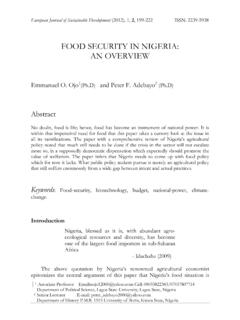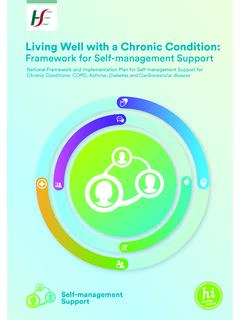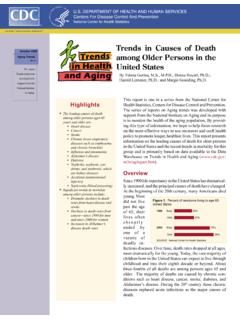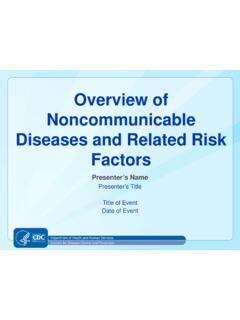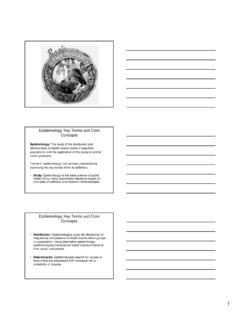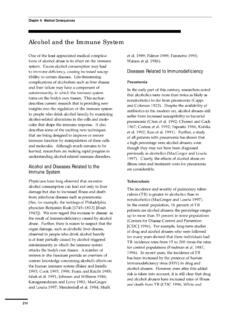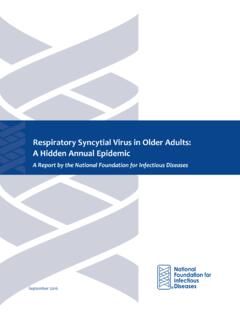Transcription of Fatigue: An Overview
1 Fatigue: An OverviewThomas C. RosenThal, mD; BaRBaRa a. majeRoni, mD; RiChaRD PReToRius, mD, mPh, and KhaliD maliK, mD, mBa, Department of Family Medicine, University at Buffalo, Buffalo, New York one fifth of family medicine patients present with fatigue, and one third of adolescents report having fatigue at least four days per men and women differ in the way they describe fatigue: men typi-cally say they feel tired, whereas women say they feel depressed or ,3 no etiol-ogy can be identified in one third of cases of fatigue.
2 Overexertion, deconditioning, viral illness, upper respiratory tract infection, anemia, lung disease , medications, cancer, and depression are common is the impairment of the nor-mal arousal mechanism and is character-ized by a tendency to fall asleep. Persons who are sleepy are temporarily aroused by activity, whereas fatigue is intensified by activity, at least in the Patients with sleepiness feel better after a nap, but patients with fatigue report a lack of energy, mental exhaustion, poor muscle endurance, delayed recovery after physical exertion, and nonrestorative sleep.
3 Figure 1 provides a questionnaire to help differentiate between sleepiness and ,6 Fatigue may be classified as secondary, physiologic, or chronic . secondary fatigue is caused by an underlying medical con-dition and may last one month or longer, but it generally lasts less than six months. Physiologic fatigue is an imbalance in the routines of exercise, sleep, diet, or other activity that is not caused by an underlying medical condition and is relieved with rest. chronic fatigue lasts longer than six months and is not relieved with should begin the evaluation of a patient presenting with fatigue by identifying common causes.
4 The doses and scheduling of prescribed and over-the-counter medications should be reviewed. medication classes that are commonly associated with fatigue, although sometimes only in the first week or two of use, include sedative-hypnotics, antidepressants, muscle relaxants, opioids, antihypertensives, antihistamines, and many types of antibiotics. even nonsedating antihistamines have an 8 to 15 percent sedation six to 12 weeks of fatigue is not unusual during recovery from even minor The quality and quantity of sleep in patients with fatigue should also be evaluated (Table 1).
5 Although it is possible for fatigue and depression to coexist, physicians should attempt to distinguish between them in order to guide management. Patients with fatigue report being unable to complete specific activ-ities because of a lack of energy or stamina, whereas grief and depression are associated with a patient description that is more global, such as being unable to do anything. Fatigue, a common presenting symptom in primary care, negatively impacts work performance, family life, and social relationships.
6 The differential diagnosis of fatigue includes lifestyle issues, physical conditions, mental disorders, and treatment side effects. Fatigue can be classified as secondary to other medical conditions, physiologic, or chronic . The history and physical examination should focus on identifying common secondary causes ( , medications, anemia, pregnancy) and life-threatening problems, such as cancer. Results of laboratory studies affect management in only 5 percent of patients, and if initial results are normal, repeat testing is generally not indicated.
7 Treatment of all types of fatigue should include a structured plan for regular physical activity that consists of stretching and aerobic exercise, such as walking. Caffeine and modafinil may be useful for episodic situations requiring alertness. Short naps are proven per-formance enhancers. Selective serotonin reuptake inhibitors, such as fluoxetine, paroxetine, or sertraline, may improve energy in patients with depression. Patients with chronic fatigue may respond to cognitive behavior therapy. Scheduling regular follow-up visits, rather than sporadic urgent appointments, is recommended for effective long-term manage-ment.
8 (Am Fam Physician. 2008;78(10):1173-1179. Copyright 2008 American Academy of Family Physicians.) Patient information: A handout on this topic is available at This clinical content con-forms to AAFP criteria for evidence-based continu-ing medical education (EBCME).Downloaded from the American Family Physician Web site at Copyright 2008 American Academy of Family Physicians. For the private, noncommercial use of one individual user of the Web site. All other rights reserved. Contact for copyright questions and/or permission American Family Physician Volume 78, Number 10 November 15, 2008 Physical examination findings that sug-gest specific secondary causes of fatigue include lymphadenopathy (indicating tumor spread or recurrence), cardiac mur-murs (endocarditis), goiter (thyroid hor-mone imbalance), edema (heart failure, liver disease , or malnutrition), poor muscle tone (advancing neurologic condition), and neurologic abnormalities (stroke or brain metastases).
9 Laboratory studies should be considered (Table 210-12), although their results affect management in only 5 percent of many physicians order a complete blood count, erythrocyte sedimentation rate, chem-istry panel, thyroid-stimulating hormone measurement, and urinalysis. Women of childbearing age should receive a pregnancy test. no other tests have been shown to be useful unless the history or physical examina-tion suggests a specific medical Managing Secondary Fatiguemedications that may be causing fatigue should be replaced or discontinued, if pos-sible, and physiologic parameters should be SORT.
10 KEy REcOMMEndaTiOnS FOR PRacTicEClinical recommendationEvidence ratingReferencesCommentsExercise therapy should be prescribed for patients with fatigue, regardless of , 32, 43, 44, 46 There is no evidence that exercise therapy worsens serotonin reuptake inhibitors, such as fluoxetine (Prozac), paroxetine (Paxil), or sertraline (Zoloft), may be helpful for patients with fatigue in whom depression is , 49A six-week trial is recommended to evaluate behavior therapy is an effective treatment for adult outpatients with chronic fatigue , 47, 48 Stimulants seldom return patients to predisease , 45 Stimulants are associated with headaches, restlessness, insomnia, and dry = consistent, good-quality patient-oriented evidence; B = inconsistent or limited-quality patient-oriented evidence.










